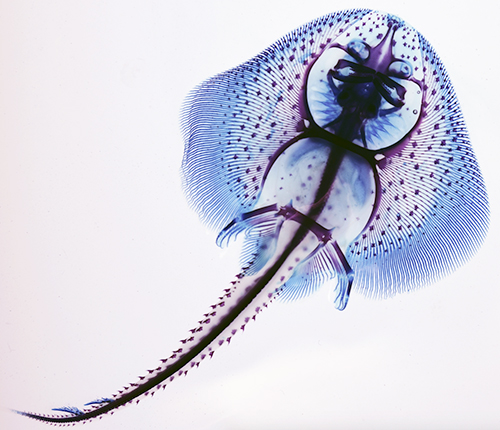Sensory systems evolve to detect and transduce stimuli that are most relevant to an animal’s physiological or behavioral context. Ancient cartilaginous fishes, such as sharks, skates, and rays, possess specialized electrosensory organs, called ampullae of Lorenzini, that sense external electric fields as small as 5 nV/cm. Electroreception is used to facilitate a variety of behaviors including predation, communication, and navigation. For example, sharks use passive electroreception primarily for predation, while skates also actively produce and sense specific electrical signals as a form of communication. How do these unique sensory systems adapt to detect behaviorally relevant signals?
 A juvenile little skate (Leucoraja erinacea) stained with Alcian blue to reveal cartilage and Alizarin red to show bony denticles. Skates and other cartilaginous fish are endowed with thousands of specialized ampullary organs which mediate the sensation of minute biogenic electrical fields. (Photo courtesy of Duncan Leitch).
A juvenile little skate (Leucoraja erinacea) stained with Alcian blue to reveal cartilage and Alizarin red to show bony denticles. Skates and other cartilaginous fish are endowed with thousands of specialized ampullary organs which mediate the sensation of minute biogenic electrical fields. (Photo courtesy of Duncan Leitch).
In this study, we analyzed shark and skate electrosensory cells to determine whether discrete physiological properties could contribute to behaviorally-relevant sensory tuning. We found that electrical signals activated shark and skate electrosensory cells through a similar low threshold voltage-gated calcium channel, but that each species employed distinct potassium channels to modulate this activity. Electrosensory cells from sharks expressed specially adapted voltage-gated potassium channels that supported large, repetitive membrane voltage spikes capable of driving near-maximal vesicular release from elaborate ribbon synapses. By contrast, skates used a calcium-activated potassium channel to produce small, tunable membrane voltage oscillations that elicited stimulus-dependent vesicular release.
 Juvenile chain catsharks (Scyliorhinus retifer) stained with Alcian blue to reveal cartilage. Sharks and other cartilaginous fish are endowed with thousands of specialized ampullary organs which mediate the sensation of minute biogenic electrical fields. (Photo courtesy of Duncan Leitch).
Juvenile chain catsharks (Scyliorhinus retifer) stained with Alcian blue to reveal cartilage. Sharks and other cartilaginous fish are endowed with thousands of specialized ampullary organs which mediate the sensation of minute biogenic electrical fields. (Photo courtesy of Duncan Leitch).
Similarly, behaving sharks responded equally to electric fields of any frequency, while skates responded specifically to low frequency signals resembling those produced by their own electric organ. We propose that these sensory adaptations support amplified indiscriminate signal detection in sharks compared with selective frequency detection in skates, potentially reflecting the electroreceptive requirements of these elasmobranch species. Our findings demonstrate how sensory systems adapt to suit the lifestyle or environmental niche of an animal through discrete molecular and biophysical modifications.
by Nick Bellono




